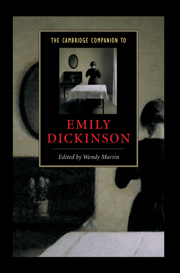Book contents
- Frontmatter
- Introduction
- Part 1 Biography and publication history
- Part 2 Poetic strategies and themes
- 4 Emily Dickinson and poetic strategy
- 5 Emily Dickinson’s existential dramas
- 6 Performances of gender in Dickinson’s poetry
- 7 Emily Dickinson
- 8 Emily Dickinson and the Gothic in Fascicle 16
- Part 3 Cultural contexts
- Select bibliography
- Index
5 - Emily Dickinson’s existential dramas
from Part 2 - Poetic strategies and themes
Published online by Cambridge University Press: 28 May 2006
- Frontmatter
- Introduction
- Part 1 Biography and publication history
- Part 2 Poetic strategies and themes
- 4 Emily Dickinson and poetic strategy
- 5 Emily Dickinson’s existential dramas
- 6 Performances of gender in Dickinson’s poetry
- 7 Emily Dickinson
- 8 Emily Dickinson and the Gothic in Fascicle 16
- Part 3 Cultural contexts
- Select bibliography
- Index
Summary
It is always tempting to regard Dickinson as a confessional poet - one whose poems, for all their innovative brilliance, are nonetheless outpourings of her own private feelings toward love, death, nature, and immortality. A closer look at her vast poetic project, however, reveals a far more complex artistic purpose, one that revels in both the possibilities and the impossibilities of language to evoke the experiences of life and mind. Dickinson, I wish to argue, constructs scenarios in verse, dramatizes the predicaments or states of mind or perceptions of imagined speakers, personae. “When I state myself, as the Representative of the Verse,” she explains to her “preceptor” Thomas Wentworth Higginson in an early letter, “it does not mean - me - but a supposed person” (L 268). The distinction is exceedingly important for she is presenting herself not as a sentimental “poetess” but as a Woman of Letters with an artistic agenda of profound scope and vision, reflecting what Matthew Arnold would term “high seriousness.” In that same letter to Higginson she proclaims, “My Business is Circumference”: a wonderfully compact way of asserting that her poetic project embraces concerns that are relevant to the entire human sphere, not just to herself.
- Type
- Chapter
- Information
- The Cambridge Companion to Emily Dickinson , pp. 91 - 106Publisher: Cambridge University PressPrint publication year: 2002
- 2
- Cited by

